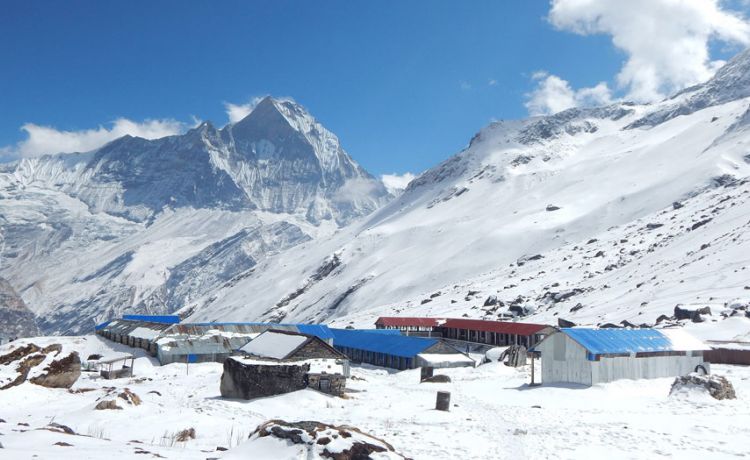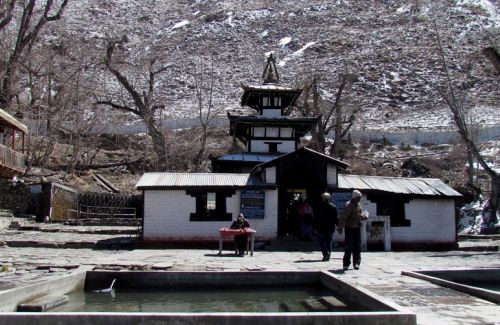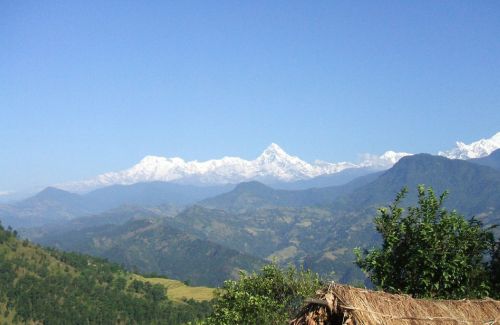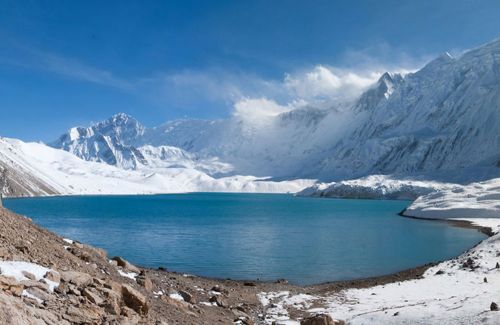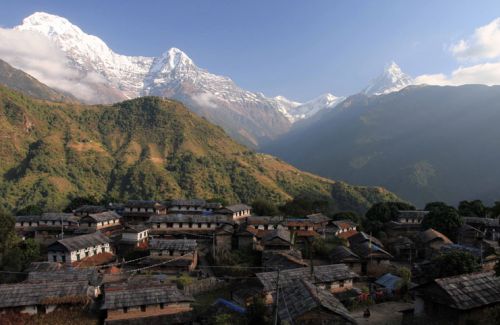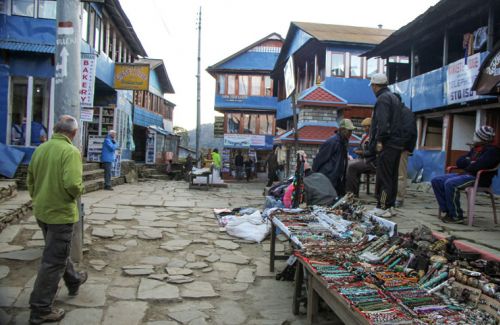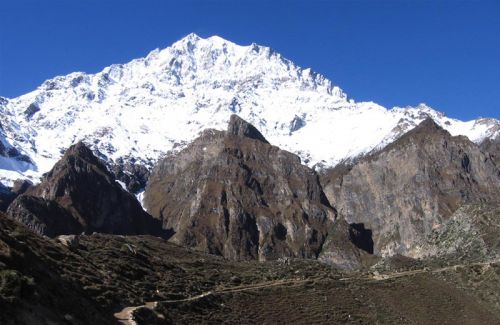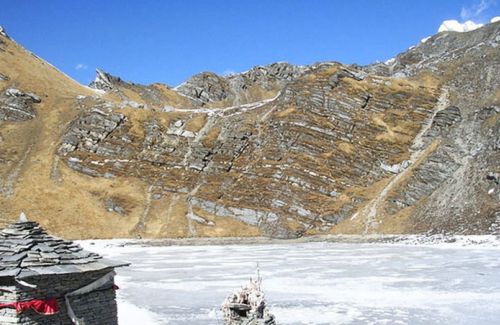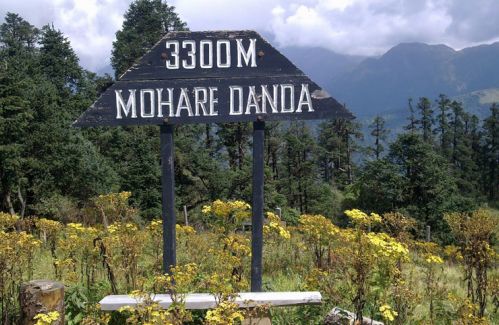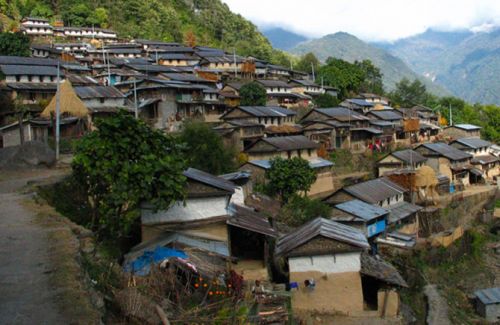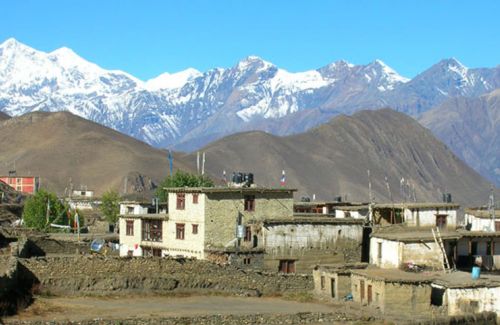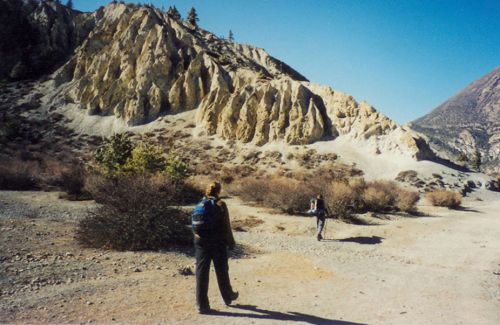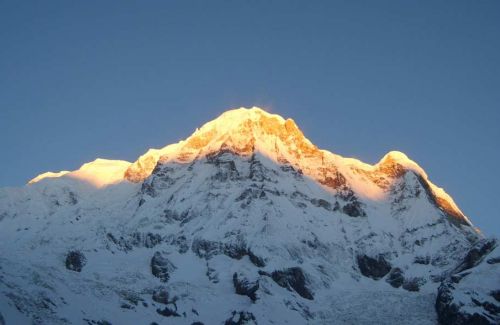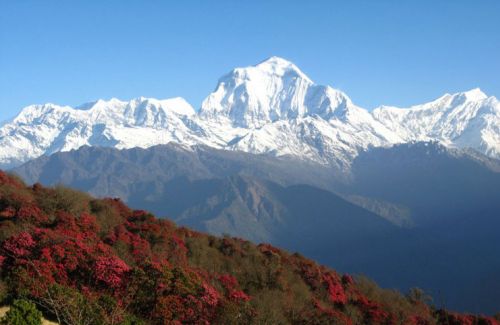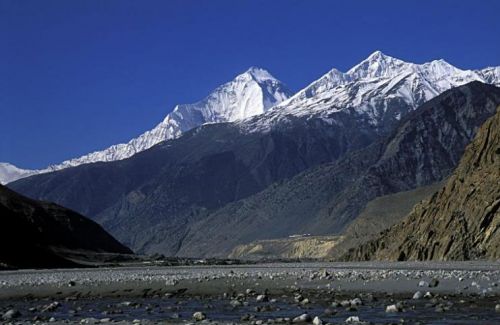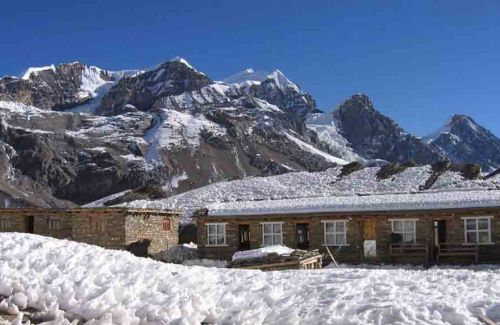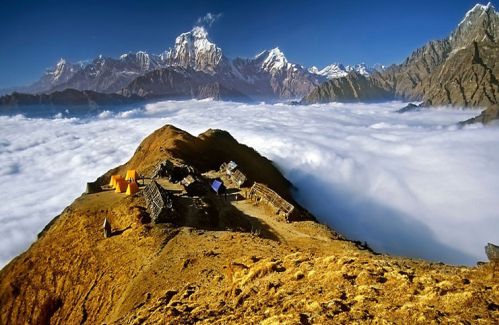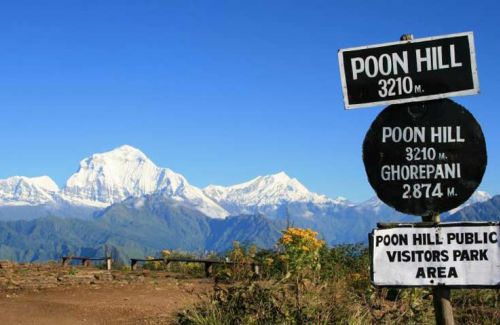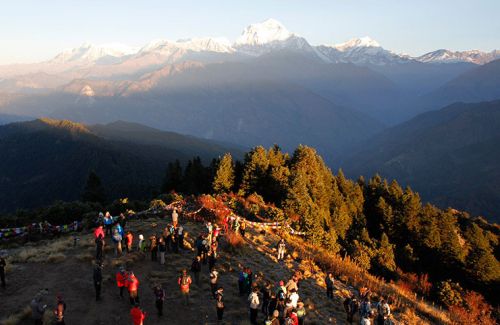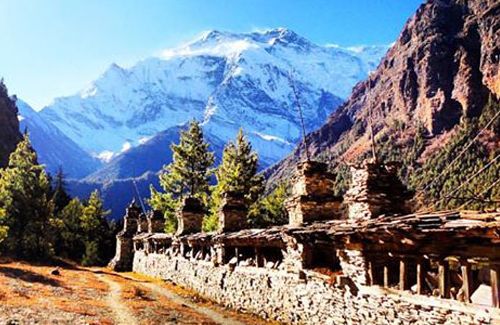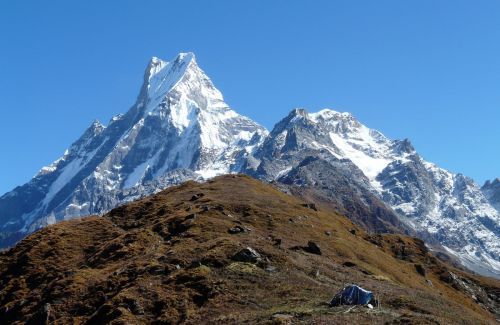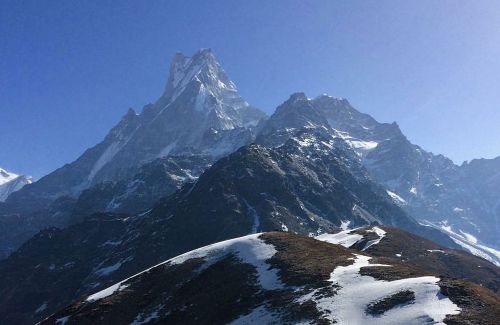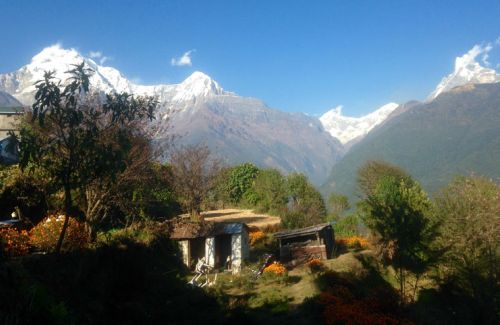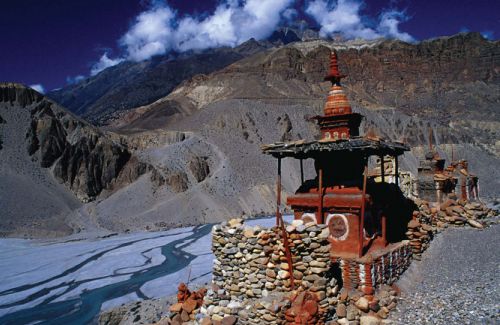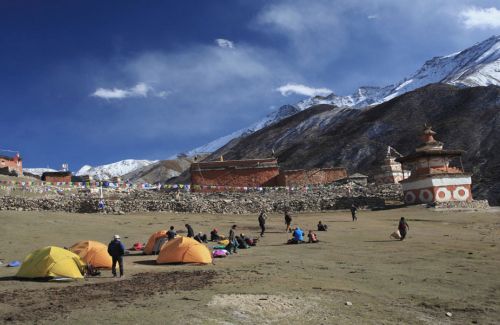ABC Trekking in Nepal
- Duration14 Days
- Max. Altitude4,130 m
Destination:Nepal
Trip Grade:Moderate (**)
Meals:Breakfast + Lunch + Dinner
Transportation:Private Vehicle/Tourist Bus
Accommodation:Lodge
Trekking Region:Annapurna Region
Show AllABC Trekking as a holiday destination
A truly cherished, highly-favored, and a daunting trekking experience, and one of the many that Nepal offers, is the Annapurna Base Camp trek. During the 11 days of the trek, one gets to witness awe-inspiring views of some of the highest mountains and be up close to the true form of nature. If there can be a daunting experience up in the mountains, the ABC trek offers it all.
Annapurna Base Camp (ABC) trek leads you right into the frozen heart of the Annapurna Range; a staggering arena of rock and ice. Starting in rice paddies, the trail leads through a gorge of bamboo and forests, ending among glaciers and soaring peaks. This 11-day trek is the most scenic moderate trek that can be done in Nepal. The trek is also known as ‘Annapurna Sanctuary’, a name coined by trekkers, denoting the high basin southeast of the Annapurna and the headwaters of the Modi Khola. Standing in the ‘sanctuary’ provides 360-degree views, which are their most beautiful at sunset. The best times for the ABC trek are spring (March-May) and Autumn (September-December). This route was not affected by the 2015 earthquake.
Ethnicity/cultural experience
This trek offers you the experience of living the traditional Nepali life in the Himalayas and witness how the locals go about their lives in hostile weather and topographical conditions. Make your way to the final destination, Annapurna Base Camp at the height of 4130m (13546ft.) through exclusive Gurung and Magar villages, lush green Rhododendron, bamboo and alpine forests.
The trail travels through beautiful Gurung villages such as Chhomrong, with its scenic suspension bridge, and Ghandruk, the largest and prettiest Gurung settlement in Nepal; which also offers sweeping views of the Annapurna and Machhapuchhare. Originally from western Tibet, the Gurung that live on the slopes of the Annapurna still practise their animist Bon faith. Distinctive aspects of the culture include the nose rings and coral necklaces worn by the women, and the village rodi, a cross between a town hall and a youth centre, where teenagers hand out and cooperative village tasks are planned. The Gurung are also well-known for their honey-harvesting. Other ethnic groups along the route include the Thakalis, traditional traders who now frequently work as hoteliers and lodge owners on the Annapurna routes; and the Chhetris, distinguished by the janai, a sacred thread worn over the left shoulder and under the right arm.
Getting there/coming back
Buses leave every 40 minutes from Pokhara’s Baglung bus stand to Phedi (Rs 70, 1.5 hours). Alternatively, catch a bus to Naya Pul (Rs 180, 2 hours), or a jeep to Kimche (Rs 300) before walking to Ghandruk.
The trek starts and ends in Pokhara, the perfect place to acclimatize before the trek and relax after. A 6-7 hour bus from KTM will take you to the city of the seven lakes where you can haveyour first encounter of the mighty Annapurna. Nayapul, the gateway from where the trekkers start their trek, is another one and a half hour jeep/taxi ride away from the city. After finishing the trek, the trekkers can come back to Pokhara to rest, relax, and enjoy.
Scenic beauty
At just the 3rd day of the trek, the trekkers get to witness the jaw-dropping mountain vista of Mount Dhaulagiri, the Annapurna Range and Mount Machhapuchhre (Fishtail Mountain) to the northern part and the Butterfly Peaks in the far western part are all visible from atop Poon Hill. Surround yourself with a 360 degree view of magnificent snow-capped mountains, standing tall and proud. The trail also takes you through natural hot water springs, said to have healing qualities.
Starting in rice paddies with spectacular panoramas of the Annapurna peaks, the trail leads through a gorge of bamboo and forests, ending among glaciers and soaring peaks. In the spring, the route is adorned with blooming, colourful and beautiful rhododendron. A notable viewpoint is Poon Hill, from where numerous peaks such as Macchapuchhare (6997m), Dhaulagiri (8167m) and Annapurna South (7219m) can be seen. The view is at its best at sunrise and can be accessed by a short 1.5km hike from a nearby lodge.The hot springs at Jhinu Danda also provide welcome relief for aching muscles on the return trip!
Difficulty level
Every trek in the Himalayas requires a certain level of physical and mental fitness. You should be in good physical shape and feel comfortable hiking up and down 7-12 miles per day whilst carrying about 10 pounds. It is recommended that you carry out at least one hour of aerobic activity 3-4 times per week for at least 1 month before starting the trek. Aerobic conditioning is important, as it enables your body to better metabolize oxygen and prepare for thinner air (there is 40% less Oxygen than at sea level). If you are in any doubt of your physical readiness, please consult with a doctor beforehand. Always remember that stamina, confidence and continuity are more important than speed.
Frequent rains make the route up the Modi Khola extremely slippery at the best of times, and in winter it can be impassable due to snow. There is significant danger of avalanches along the route to the ABC between Doban and Machhapuchhare Base Camp. Trekkers have died, and parties have been stranded in the sanctuary for days, the trail being blocked by tonnes of ice and snow. Always check with the ACAP office in Chomrong and lodges in Deorali for a report on current trail conditions, and do not proceed if there has been recent heavy rain or snow.
Best Advised Seasons
Autumn (Sept. to Nov.) and spring (March to May) are the best advised seasons for the Annapurna Base Camp Trek. The weather being sunny and warm facilitates outstanding views. Experience this daunting trek with your friends and go back home spiritually, physically, and mentally enriched and enlightened.
Packing List for ABC Trek
If you are planning to venture on the ABC trek, these are the things you ought to carry with yourself:
- ravel documents: passport, visa, travel insurance, air tickets, voucher, passport sized photos
- Binoculars, alarm clock and torch/flashlight/headlamps, ear plug and eye mask,
- Reading and writing materials, travel games like , chess, backgammon, scrabble,
- Hand sanitizer, lip balm, face and body moisturizer, light weight towel, toiletries like toothbrush, toothpaste, multipurpose soap, deodorant, nail clippers, sanitary pads
- Money-cash and money bag,
- Sleeping bag
- Day pack (with waist straps), refillable water bottle
- Sun hat, sunglasses, scarf
- Bag liner,
- Sewing kit, swiss army knife, lighter, a small padlock
- Wind and waterproof shell jacket and trousers
- Comfortable walking shoes, running shoes and sandals
- Socks: thick wool blend and thin cotton to be worn in combination
- Lightweight thermal gloves
- T-shirts
- Underwear and shorts
- Long sleeved shirt
- Trekking/Hiking boots with spare laces
- Lightweight long trousers
- First Aid Kit
- Regular medicines
If travelling during winter:
- Layered clothing/thermals
- 1 heavyweight or 2 light weight wool jumper/sweater/fleece jacket
- Fleece wind-stopper jacket
- Down jacket or down vest
- Fleece or wool trousers
- Heavyweight gloves or mittens
- A four season sleeping bag
- Thick, warm wool hiking socks
- Optional Gaiters
Further afield
ABC trek can be done in 7 days, but it is far more rewarding to spend up to 11 to fully appreciate all that the route has to offer. This trek can also be combined with the Annapurna Circuit trek for a longer 30-day walk. Other treks in the region include Ghorepani Poonhill, Jomsom Muktinath, Tilicho Lake, Nar Phu Valley, Khayer Tal, Mardi Himal, Upper Mustang, Siklesh and Royal Trekking.
Trip Highlights
- Enjoy Free Walking Tour organized by an experienced guide by Himkala Adventure
- Scenic bus drive from Kathmandu to Pokhara
- Visit Pokhara, the city of adventurers hub and enjoy Phewa Lake
- Great Annapurna ranges view from the top of Poonhill
- View the Kali Gandaki Valley view and Dhaulagiri Ice fall
- Meet different ethnic group and interact with them
- Enjoy ABC trek with scenic mountain view and local culture
Day to Day Itinerary
Day 01:Arrival in Kathmandu (1,350 m),transfer to hotel. Overnight at hotel
Day 02:Free Walking Tour Kathmandu, 4-5 hrs, visiting local areas, and Monkey Temple. O/N at Hotel
Day 03:Drive to Pokhara (827 m) by Tourist Bus 6-7 hours. O/N at Hotel
Day 04:Drive to Nayapul (1,010 m) and Trek to Ulleri (1,960 m), 4 hrs. O/N at Guesthouse
Day 05:Trek to Ghorepani (2,840 m),5 hrs. O/N at Guesthouse
Day 06:Hike up to Poon Hill (3,210 m) and Trek to Tadapani (2,610 m), 7 hrs. O/N at Guesthouse
Day 07:Trek to Chomrong (2,140 m), 5 hrs. O/N at Guesthouse
Day 08:Trek to Himalaya Hotel (2,950 m), 6 hrs. O/N at Guesthouse
Day 09:Trek to Annapurna Base Camp (4,130 m), 7 hrs. O/N at Guesthouse
Day 10:Trek to Bamboo (2345 m), 6 hrs. O/N at Guesthouse
Day 11:Trek to Jhinu (1,780 m), 5 hrs. O/N at Guesthouse
Day 12:Trek to Nayapul (1,010 m), Drive to Pokhara, 5.5 hrs & visit Barahi Temple,Fewa Lake. O/N at Hotel.
Day 13:Drive from Pokhara to Kathmandu, 6-7 hours. O/N at Hotel
Day 14:Departure to the airport
Cost Include
- Airport picks up and drops off
- Drive Kathmandu – Pokhara – Kathmandu by Tourisr Coach
- Kathmandu/Pokhara Sightseeing
- Hotel in Kathmandu & Pokhara with Breakfast (Hotel Category as per your choice)
- Full Board meal during the trek
- Tea House, lodge, Guest House Accommodation during the trek
- Annapurna Conservation Area Entry permit
- TIMS (Trekker’s Information Management System) Fee
- Experienced English Speaking Trekking Guide
- Local Trekking Porters(2 Trekkers = 1 porter)
- Food, Salary, Accommodation and Insurance of Guide and Porters
- Down Jacket, Duffel Bag, and Sleeping bag by Himkala Adventure if required
- Government Tax,Service Charge and other applicable taxes
- Dinner after completion of your trek with Nepalese cultural show
Cost Exclude
- Lunch and Dinner in Kathmandu and in Pokhara
- Entrance Fees of all visiting monuments during tour
- Nepal Entry Visa Fee
- Personal Expenses ( Phone Bills, Bottled or Boiled water, Bar, Laundry, Shower etc.)
- Your Travel Insurance
- Emergency Rescue Evacuation
- Tips to Trekking, Tour Staff and Driver (Tipping is expected)
- Any other expenses that has not been mentioned in the Cost Includes Section
